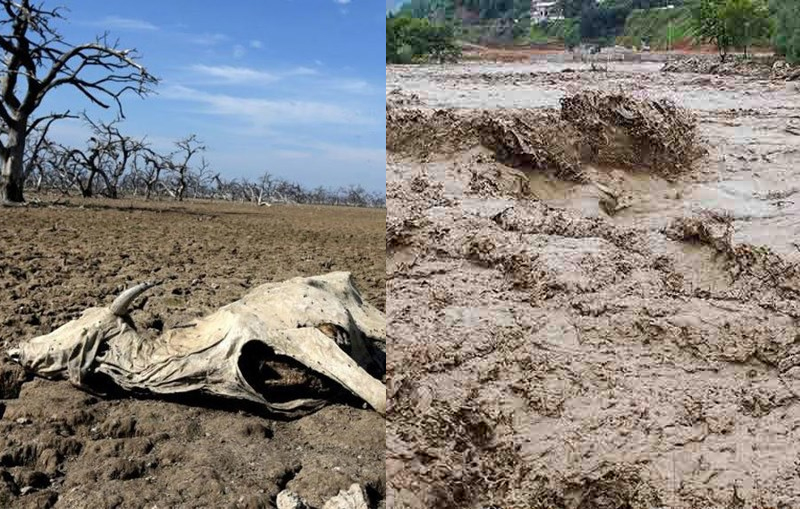Afghanistan is one of the countries that is highly prone to a number of natural disasters like earthquakes, flooding, drought, landslides, and avalanches & man-made disasters. It is common to have in the spring when snow begins to melt and rainfall is heavy & in south and southeast often trigger drought floods. More than four decades of war and civil conflict, as well as environmental degradation, have all contributed to increasing vulnerability of the Afghan citizens to natural disasters. On the other hand, according to the research findings, Afghanistan faces significant shortcomings in the areas of water, sanitation, health, security and natural resource management.
No one claims that, it is possible to completely avoid natural disasters; indeed the government can reduce the sufferings by creating proper awareness of the likely disasters and its impact by developing a suitable warning system, disaster preparedness and management of disasters through application of information technology tools. In fact, poor disaster management is one of the main causes of huge sufferings and causalities in Afghanistan.
During recent days flood hit Samangan, Takhar, Kapisa, Baghlan, Badakhshan, Badghis, Ghor, Panjshir, Sari Pul, Ghazni and Parwan provinces of Afghanistan. According to the ANDMA, at least 34 people died and 4 injured in flash floods in Afghanistan recently. This report added that the flooding had affected 11 provinces. Around 600 animals had died, 240 houses were destroyed and 624 houses were damaged. And around 80 hectares of agricultural land was also severely damaged.
In addition to flood, according to an analysis of climate and drought records by the Asian Development Bank , localized droughts in parts of the country have a return period of three to five years, while drought covering large areas recurs every 9-11 years. The recent drought in the country, is unusual and perhaps the worst in country’s history. Of the 32 provinces, drought has a high frequency in the provinces of Herat, Ghor, Uruzgan, Ghazni, Faryab, Jawzyan, Balkh, Samangan, Kunduz and Badakshan. The provinces of Takhar, Bagkan, Saripul, Badghis, Bamyan, Wardak, Lagghman, Kunar, Nangarhar, Paktiya, Khost, Farah, Zabul, Paktika, Nimroz, Hilmand, and Kandahar face medium risk of drought.
Poor Policies and Practices for Flood and Drought Risk Management
Social scholars argue that building social resilience to water-related disasters in any country is a slow process of evolution in thinking, negotiating and developing the frameworks to understand and manage risk. It requires developing step by step, policies and practice, put them in place and test them as required. To this end, Afghanistan needs to develop and put in place integrated flood and drought management policies.
Integrated Flood Management
An integrated flood management policy should firmly be rooted in and take its principles from IWRM, integrated land, water and risk management. Doing so, it is recognized that floods can never be fully constrained; meaning that they do not only pose a threat but also have beneficial impacts, and these impacts affect many sectors of economy in a given context. As such, it makes the government authorities to shift the focus from flood control to flood management and to flood risk reduction. In this context, the authorities just by taking the whole catchment to consideration in the long term can decide about the best use of scarce resources, and unintended consequences can be avoided. According to this approach, the disaster management authority can manage the water cycle as a whole, integrate land and water management; access and manage risk and uncertainty; adopt a best mix of strategies; ensure a participatory decision-making approach with a range of stakeholders; and adopt integrated risk management approaches.
Integrated Drought Management
Drought management is the opposite of flood management; it focuses on preparedness, prevention and mitigation. Indeed, it takes place in a very different context, since the floods often appear rapidly, while droughts are slow-onset, and have a longer time frame for prediction and diagnosis. In the past in terms of tradition drought management, the approach was focused on an emergency, humanitarian response to hunger and loss of livelihoods. While the integrated approach focuses on the whole cycle of disaster management, with focuses on the risk management aspect of the cycle.
Disaster management, including flood and drought management, requires integrated policies and plans. In other words the Government authorities need a perception shift; changing their approaches from disaster control to disaster management. Disaster control only considers one aspect of the phenomena and only addresses it in a short term period and neglects the other aspects of the problem; while in disaster management different aspects of a problem is considered duly and are addressed systematically. As such, the heavy burden of flood and drought on the shoulders of the citizens of Afghanistan is the outcome of the wrong policies and plans of the disaster management authorities, lacking an integrated approach to disaster management.
Home » Opinion » Flood and Drought: Extra Burdens on the Shoulders of Afghan Citizens
Flood and Drought: Extra Burdens on the Shoulders of Afghan Citizens
| Moh. Sakhi Rezaie

